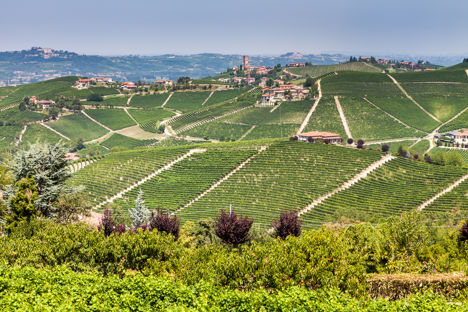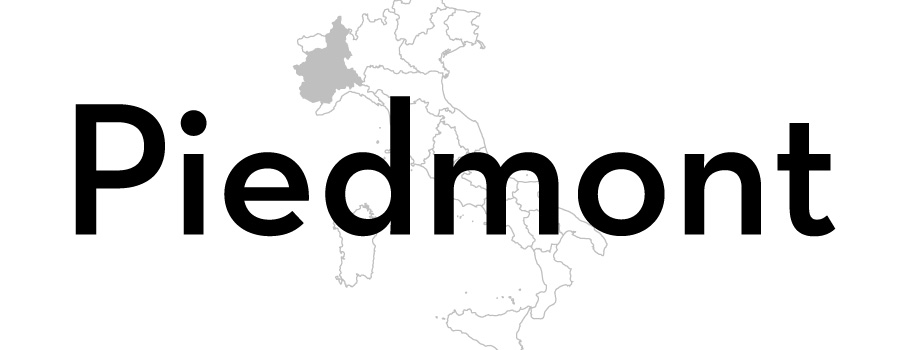
The wines of Piedmont
Marco Rossi turns his attention to the mountainous northern region of Piedmont, and the wide variety of protected wines that highlight the incredible Nebbiolo grape.
View more from this series:
Italian wineWriting about Piedmont's wines is never simple. Just thinking about this beautiful region fills me with a warm, comfortable awe that’s present every single time I stand before the wines of Gaja, Conterno or Fenocchio.
When you observe His Majesty Barolo dancing around in a tasting glass, it’s almost as if the wine's slow, rhythmic movements are moving in time to music. Nebbiolo, the real pride of this region that gives life to the Barbaresco and Barolo, is one of the most elegant grape varieties in the world and is very difficult to grow, just like Pinot Noir and Sangiovese.
Piedmont is a majestic, serious and austere region; it gives off an almost black and white vintage atmosphere, while its high altitude means there’s always a chill in the air. It dominates your feelings with its tall mountains, but at the same time the sun on the Langhe is warm, colorful and elegant enough to make this area a UNESCO world heritage site. The blend of rich culture, centuries-old tradition and stunning landscapes can all be tasted in Piedmont’s unique wines, which withstand the flow of time without compromise.
The amazing thing is that this region has no IGTs; the only appellations are seventeen DOCGs and forty-four DOCs. These appellations, however, cover more than eighty percent of Piedmont's production, underlining the attachment this region has to its great winemaking traditions. The clash between traditionalists and modernists has only come to the surface in modern times.
The grapes grown in Piedmont are mostly red, but the cool climate and a particular terroir also allows the production of great quality white wines and historically even some sparkling.
• The Ancient Greeks started the grape growing tradition in Piedmont
• The Romans really appreciated the grapes they found on this land
• Nebbiolo started becoming famous in 1000AD
• By the early 1500s, the wines of Piedmont were enjoyed in the papal court
• In the late 1600s, Louis XIV seemed to appreciate the wines of this territory as they resembled French varieties
• Vermouth was invented in Turin at the beginning of the 1700s
• In 1843, the Count of Cavour, a politician and wine producer, decided to catalogue the great heritage of grapes found at the highest peaks in Piedmont
• Today, Piedmont is among the most important Italian regions for both the quantity and the quality of wine produced
DOCG wines
The king of wines – or wine of kings, as it is often defined – is called so because of its quality features, slow evolution time and the very low yields the grapes produce. The only grape allowed in Barolo is Nebbiolo, which just like a wild horse does not want to be tamed by time or nature. His energy and elegance can lead to incredible wines that require at least thirty-eight months of aging (and up to a minimum of sixty-two months for the riserva). Sometimes you will need to wait twenty years for a bottle of Barolo to fully express itself!
Visual: garnet red, quite transparent and with orange shades
Bouquet: huge – a wide range of aromas characterized by red berries, jam and spices; undergrowth like mushrooms, truffles and moist earth and hints of tobacco, leather and cocoa powder
Taste: soft, salty and tannic accompanied by a hint of acidity that is evidence of a long aging potential
Pairing: with the traditional Piedmontese bagna cauda (an anchovy-based dip), civet of hare or red meat, truffles and mature cheeses
Must try:
Traditional: Giacomo Fenocchio – Bussia Barolo DOCG Riserva
New Wave: Elio Actare – Brunate Barolo DOCG
Barbaresco is one of the oldest wines of Piedmont and unlike Barolo was already one of the greatest expressions of Nebbiolo during Roman times. It is still one of the best wines of this region, despite having undergone several changes regarding production techniques. The hills that are home to the vines are more gentle than Piedmont’s typical geography and even altitudes are minor – although the climate still proves a challenge when trying to ripen the ‘Prince of the Grapes’. The refinements range from a minimum of twenty-six months for Barbaresco to a minimum of fifty months for the riserva and, like Barolo, Barbaresco can last for quite a long time.
Visual: garnet
Bouquet: elegant with scents of violet, red fruit jam, a sweet spiciness of vanilla, cinnamon and nuts and, like Barolo, hints of tobacco and leather
Taste: velvety and soft, tannic and well-structured
Pairing: red meats with long cooking, game and aged cheeses such as Piedmont’s famous Bagoss
Must try:
Traditional: Giuseppe Cortese – Barbaresco DOCG Rabajà
New Wave: Nada Fiorenzo – Barbaresco DOCG Manzola
There are three main areas in which you will find the production of Dolcetto DOCG. Of course, each one imparts its own peculiar characteristics onto these wines, which are strictly made with 100% Dolcetto grapes.
The grape at the base of Dolcetto wines has a quite strange characteristic – it matures quite fast. The name Dolcetto means ‘quite sweet’ and refers to the high concentration of sugar present in the berries. The characteristics imparted by the three regions don’t take very long to appear; in fact, Dolcetto reflects the flavour of the vineyard and is ready to drink quite quickly. They need to be consumed within five years of production, so remember to always check the vintage!
Visual: intense ruby red with violet shades
Bouquet: very fruity with strong notes of cherry and tiny flowers, reaching herbaceous nuances
Taste: dry, warm and soft enough with tannins of good quality and a relatively high salinity
Pairing: Piedmontese Bollito Misto (a north Italian meat stew)
Must try:
Traditional: Az. Agricola Cascina Gentile – Dolcetto Ovada DOCG
New Wave: San Fereolo – Dolcetto di Dogliani DOCG
There are two DOCGs based on the Barbera grape, both enabling a very light blend: Barbera del Monferrato and Barbera d'Asti. The first represents the oldest area where it was cataloged – Barbera itself is not an ancient grape but probably evolved from native antique varieties. These wines are characterized by an altitude of 700 metres and a maturation of at least six months in oak casks, respecting the French tradition barrel-aging. Overall, the minimum refining time is at least fourteen months, but the ideal time of consumption is limited to a maximum of five years.
Visual: ruby red with garnet shades
Bouquet: fruity with clear notes of cherry, blackberry and plum with floral notes in the background
Taste: remarkable freshness with tannins – not too aggressive and it is really easy to drink
Pairing: boiled and tender red meats
Must try:
Traditional: Castle Uviglie – The Cave Barbera del Monferrato Superiore DOCG
New Wave: Marco Bonfante – Red Star Barbera del Monferrato Superiore DOCG
DOC wines
• 25,400 square kilometers of land
• Forty percent of the region is mountainous, thirty percent is hilly with really high peaks
• Piedmont literally means ‘at the foot of the mountain’
• There are over 50,000 hectares cultivated with vines
• The most important grape is Nebbiolo
Even among the DOCs Nebbiolo dominates the Piemontese scene, and eighty-five percent of this extremely rare wine has to be made with the grapes. It then has to be left to mature for at least twenty-two months (and at least forty-six months for the riserva), but does not evolve much, rarely exceeding five years.
The territory in which this wine finds its natural placement is tiny, and to track down a bottle in foreign markets is really difficult. Those lucky enough to taste a Lessona should share that bottle with the people they love (and with a guy named Marco Rossi).
Visual: intense ruby red
Bouquet: fruity with hints of strawberry and red fruits that give way to hints of violets
Taste: A wine that tends to become balanced in the short term with softness and good tannins as well as an interesting freshness
Pairing: fondue, cheese and wild game
Must try:
Traditional: Sella – Tribute to Quintino Sella Lessona DOC
New Wave: Az. The Badina – Lessona DOC
Almost a Nebbiolo, since it has to be made with eighty-five percent Nebbiolo grapes, Carema grapes are grown in an heroic way on terraces throughout a rugged mountainous landscape that is anything but gentle. To soften this grape from a difficult territory, refinements take place in wooden barrels for at least thirty months. Overall, Carema wines can be left in the bottle for up to fifteen years.
Visual: garnet
Bouquet: rose and violet with macerated red fruit and pepper, as well as the tobacco and leather you would expect in important Nebbiolo wines
Taste: very tannic but balanced
Pairing: pasta dishes with meat sauces
Must try:
Traditional: Cantina Produttori Nebbiolo of Carema – Carema Riserva DOC
New Wave: Ferrando – Black Label Carema DOC

